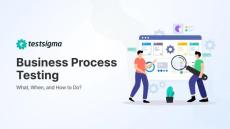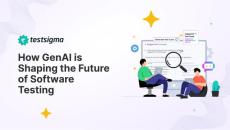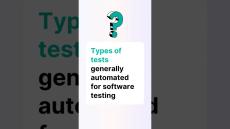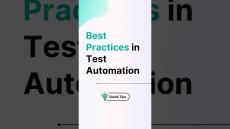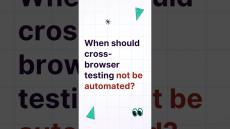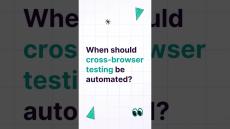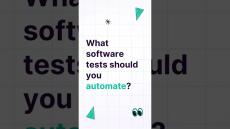|
By Python Code Nemesis
Web applications are being developed and deployed at an extremely fast rate. This makes it important to have robust testing mechanisms in place. Web tests need to ensure seamless user experience across browsers and devices. Web testing tools enable you to write tests for user journeys, which is the difference between happy users and a critical feature not showing up in production! Writing these tests manually is a hassle and web testing automation tools help streamline this process.
|
By Raunak Jain
When it comes to automated testing frameworks, Gauge and Selenium are two popular tools. Selenium is an old and trusted framework. It is widely used for browser automation. Testers can use it to simulate user actions on web apps across browsers. Gauge is different. It is a lightweight, open-source tool. It allows writing test cases in a simple and easy-to-read format. This helps developers, testers, and stakeholders work together better. Both tools are good in their areas.
|
By Raunak Jain
TestCafe and WebdriverIO are both popular tools for testing web apps. In this article, let’s understand the differences between Testcafe and WebdriverIO and see why all-around cloud test automation tools like Testsigma are always a better alternative. Check out how Testsigma compares with other test automation tools.
|
By Raunak Jain
ACCELQ and Copado are two cloud-based platforms that enrich software development and delivery processes. In this article, let’s discuss more about the testing capabilities of ACCELQ and Copado, highlighting the key differences between them and understanding where AI-powered alternatives like Testsigma could be a better choice for comprehensive testing needs. Additionally, you can also check out this guide on low-code test automation.
|
By Raunak Jain
In the ever-evolving world of business, efficiency and effectiveness are paramount. Organizations strive to optimize operations, reduce costs, and deliver exceptional customer experiences. At the heart of this lies business process testing (BPT). This article delves into the what, when, and hows of BPT, allowing organizations to leverage its power for continuous improvement and sustained success.
As software development accelerates, Quality Assurance teams are facing unprecedented pressure to deliver both speed and quality. Despite exponential innovation in software development over the past couple of decades, QA teams still seem to be grappling with the fact that testing is not happening at the same speed as development happens.
|
By Raunak Jain
Tools like Cypress and BrowserStack provide strong solutions for end-to-end testing and cross-browser testing. Cypress is an open-source tool. It’s known for running fast and reliable tests. Plus, writing tests with it is simple, especially for modern web apps. BrowserStack, on the other hand, is a cloud-based platform. It gives us access to many real devices and browsers. This makes it easy to test on different environments without setting up physical devices.
|
By Raunak Jain
Kobiton and pCloudy are mobile testing tools that allow us to run tests on real devices, help with test automation, and debug how your app runs. Kobiton is great because it uses AI to make testing easy and quick, it’s good for teams who want quicker results. pCloudy on the other hand, also has lots of devices you can test on, it integrates well with CI/CD and helps teams work together on bigger projects.
|
By Agrim Ahluwalia
Today, various phases of testing help detect and correct issues at different levels of product development. Gamma testing is the last step that checks performance, quality, safety, and functionality before the product reaches end-users. Knowing why it matters and how it is executed helps developers create a reliable product that’s ready for the market.
|
By Meenakshi M
GenAI in software testing emerged as a crucial solution, helping organizations align testing speed and efficiency with the pace of software development. If we look at software testing processes over the years, manual testing has played a crucial role but has also faced challenges in terms of speed and accuracy, especially with repetitive, complex, and time-consuming tasks. This led to the adoption of automated testing, which helped but still needed manual test creation and management.
|
By Testsigma
There are some major factors testing experts look into before selecting an automation tool, Use Testsigma for GenAI-powered codeless test automation to achieve higher test ROI and efficiency.
|
By Testsigma
Use Testsigma for a higher and faster ROI for your test automation.
|
By Testsigma
Save testing time and effort using intelligent test automation. Use Testsigma for 10x faster test automation.
|
By Testsigma
Use Testsigma for a higher and faster ROI on test automation.
|
By Testsigma
1. Ensures the application works perfectly and seamlessly on all browsers, devices, platforms, and versions. With Testsigma, automate your cross-browser tests 10X faster on the cloud. Achieve over 70% coverage by testing your apps on over 3000+ real devices/browsers/platform versions on the cloud. Use Testsigma for a higher and faster ROI for your cross-browser test automation.
|
By Testsigma
- When your application is not stable and the UI identifiers keep changing Use Testsigma for a higher and faster ROI for your cross-browser test automation.
|
By Testsigma
1. When the same test case is being executed on different device combinations multiple times Use Testsigma for a higher and faster ROI for your cross browser test automation. Signup here: testsigma.com/signup.
|
By Testsigma
- When the application you are testing is unstable. Tip: Do not include unplanned test cases and those that return unpredicted results. A balance of manual and automated testing will help achieve a better ROI. Use Testsigma for a higher ROI. testsigma.com/signup.
|
By Testsigma
Signup for a free trial of Testsigma. The link is available on the channel page. Testers usually prefer automating these tests.
|
By Testsigma
Testsigma Copilot is a GenAI assistant for QA teams that lets you generate test cases and scenarios with just designs, screenshots, or user stories. ️ No manual test development effort️ No missed edge cases️ No delayed or lengthy test cycles.
- March 2025 (1)
- February 2025 (16)
- January 2025 (11)
- October 2024 (1)
- April 2024 (3)
- February 2024 (1)
- January 2024 (1)
- December 2023 (2)
- October 2023 (1)
- September 2023 (1)
- July 2023 (3)
- June 2023 (17)
- May 2023 (24)
- April 2023 (36)
- March 2023 (24)
- February 2023 (24)
- January 2023 (46)
- December 2022 (25)
- November 2022 (25)
- October 2022 (13)
- September 2022 (17)
- August 2022 (8)
- July 2022 (14)
- June 2022 (19)
- May 2022 (6)
- April 2022 (4)
- March 2022 (4)
- February 2022 (5)
- January 2022 (5)
- December 2021 (1)
- November 2021 (4)
- October 2021 (3)
- September 2021 (14)
- August 2021 (9)
- July 2021 (13)
- June 2021 (14)
- May 2021 (13)
- April 2021 (9)
- March 2021 (5)
- February 2021 (12)
- January 2021 (9)
- December 2020 (13)
- November 2020 (2)
- October 2020 (4)
- September 2020 (1)
- August 2020 (4)
- July 2020 (4)
- June 2020 (3)
- May 2020 (7)
- April 2020 (5)
- March 2020 (5)
- February 2020 (5)
- January 2020 (5)
- December 2019 (5)
- November 2019 (1)
- May 2019 (1)
- April 2019 (1)
- March 2019 (1)
- November 2018 (1)
- July 2018 (1)
- May 2018 (10)
- April 2018 (1)
Unified continuous testing tool to automate end-to-end testing for web, mobile apps & APIs.
Testsigma lets everyone including SMEs and QAs write automated tests at least 5X faster using simple English and intuitive interface. Reuse existing step groups. Write Selenium and JS based custom functions to extend Testsigma to your custom requirements. Near zero initial time, cost and resources required. No tool setup or ramp-up delay! Testsigma is a cloud-based Test Automation Ecosystem with all the essential elements required for test automation.
AI-driven continuous testing platform for continuous delivery:
- Fully loaded Test Lab on the cloud to run tests: Inbuilt test lab on the cloud with 1000+ OS/Browser/Version combos and 2000+ real mobile devices to run thousands of tests in minutes. Create and run Test Suites across different browsers, versions, operating systems, and devices. Run tests on Real Device Cloud with a range of physical Android and iOS mobile devices. Test internal applications on your local devices.
- AI to reduce Maintenance efforts & improve Productivity: Dynamic Locator Strategy that saves test maintenance time by 70%. Identifies affected tests and potential failures upfront to save execution time & cost. Saves time and effort required in manually identifying the affected tests when the application changes. Creates a test plan automatically based on past result trends.
- Scalable Test Lab on the cloud for Parallel Test Executions to save Time & Cost: Run thousands of tests in minutes in parallel for faster feedback. Parallel Test Executions to reduce regression testing time from weeks to minutes. Scalable Test Lab on cloud with thousands of test devices/machines to run your tests in parallel for faster feedback in Agile and DevOps.
- Continuous Testing, CI/CD support for Agile and DevOps Teams: Shift-Left approach, CI/CD integration, and fast feedback to accelerate the delivery of web & mobile apps. Built for Continuous Testing with a Shift-Left approach to start automation testing right form your design phase.
Sign up for free and get started with test automation on the cloud within minutes!




